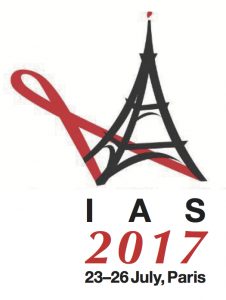Reduced-dose darunavir is safe and effective in switch study
10 August 2017. Related: Conference reports, Antiretrovirals, IAS 9th Paris 2017.
 Polly Clayden HIV i-Base
Polly Clayden HIV i-Base
A 400/100 mg once-daily darunavir/ritonavir (DRV/r) dose plus two NRTIs maintained virologic efficacy through 48 weeks in participants previously suppressed with DRV/r 800/100 mg. [1]
These data from the ANRS-165 Darulight study were shown at IAS2017.
Darulight was a multicentre, phase 2, single arm, open label study in stable participants with viral load <50 copies/mL who had received DRV/r 800/100 mg for at least 12 months.
Of 100 participants enrolled in the study, 95 were included in the modified intent to treat analysis.
A minimum of 94 participants were needed to detect a difference in success rate from 80% to 90% with 85% power.
Participants were a median age of 43 years and 78% were male. They had received ART for a median of 46 months, and had a median CD4 count of 633 cells/mm3 and duration of viral load <50 copies/mL of 35 months. The majority (76%) received a TDF/FTC backbone and the remainder ABC/3TC.
At 48 weeks 87 of 95 participants had viral load <50 copies/mL: 91.6% (95% CI 84.1 to 96.3), p<0.001. Of the remaining 8 participants: 2 changed DRV dose without virological failure; 6 had viral load >50 copies/mL (2 >200 copies/mL).
The only risk factor for viral load >50 copies/mL was baseline peak viral load >threshold: OR 4.76 (95% CI 1.47 to 15.4), p=0.009.
Nine participants had serious adverse advents, none led to treatment discontinuation.
A pharmacokinetic sub study of Darulight conducted in 15 men found total and unbound blood and seminal plasma exposure of DRV to be not significantly different between both doses, despite 50% dose reduction. [2]
Unexpectedly total blood plasma exposure of ritonavir trended to be higher in 400/100mg once-daily, than in 800/100mg once-daily (p=0.09) due to a change in the inducer/inhibitor balance between DRV and RTV.
comment
DRV has long been a candidate for dose optimisation and these data support further investigation.
A DRV/r 400/100 mg switch trial in South Africa is currently enrolling participants, stable on boosted lopinavir-based second-line. [3]
And plans for phase 2 and 3 studies in unsuppressed participants are underway.
Fit for Purpose July 2017 gives more details [4]
References:
- Molina JM et al. Efficacy and safety of 400 mg darunavir/100 mg ritonavir with TDF/FTC or ABC/3TC in virologically suppressed HIV-1 infected adults: an open-label study – ANRS-165 Darulight. IAS 2017. 23–26 July 2017. Paris. Poster abstract MOPEB0313.
http://programme.ias2017.org/Abstract/Abstract/1075 - Lê MP et al. Pharmacokinetic modelling of darunavir/ritonavir dose reduction (800/100 mg to 400/100mg once daily) containing regimen in virologically suppressed HIV-infected patients as maintenance treatment: ANRS-165 DARULIGHT sub-study. Poster abstract MOPEB0329.
http://programme.ias2017.org/Abstract/Abstract/1586 - US National Institutes of Health. Evaluation of low-dose darunavir in a switch study (DRV).
https://clinicaltrials.gov/ct2/show/NCT02671383 - Clayden P. Antiretroviral treatment optimisation for adults and children. Fit for Purpose. 24 July 2017.
https://i-base.info/htb/32022

